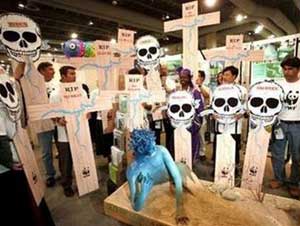World Water Day: Warnings from Vietnam
Finding the best solution - both scientific and containing cultural elements - to improve water resources is the message that the United Nations launched on World Water Day (March 22) this year.

Staff of the World Wildlife Fund (WWF) holds banners bearing the names of rivers that are in danger of exhaustion - Photo: Reuters
Water resources are exhausted, water quality is being alarmed, lack of clean water to use is a common pressure of many countries in the world, in which Vietnam is not an exception . In Vietnam, currently only About 60% of urban areas have centralized water supply systems.
The standard for water supply for small and medium urban areas is 75-80 liters / person / day, for big cities is 100-150 liters / person / day. About 40% of the urban population suffers from water shortages and the percentage of rural people who have access to clean water is only 40-60%.
Nearly all major rivers in Vietnam must carry waste from urban areas and industrial parks. According to the monitoring results of the Department of Environmental Protection, in most major rivers, BOD5 content (the amount of oxygen needed for microorganisms to oxidize organic substances by reaction) and N-NH4 exceeds the standard from 1.5-3 times.
The suspended solids content measured in ponds and main canals exceeds the standard of Class A by 1.5-2.5 times. Particularly, the coliform index (bacteria strain causing diarrhea and shrinkage) in some large rivers has exceeded the permitted standard by 1.5-6 times.
In big cities like Hanoi, Hai Phong, Ho Chi Minh City, Hue ., the system of lakes and canals and small rivers is often the place to receive and transport waste water of industrial parks and zones. residential. Currently this system is already in serious pollution, exceeding the standard by 5-10 times (for water sources of standard B). Lakes in the inner city are in a state of re-contamination with organic matter.
Meanwhile, groundwater in many coastal areas has been saline. In the Northern Delta and Mekong River Delta, excessive water exploitation has lowered the water table. Many places show signs of phosphate and arsenic contamination. In Hanoi, the number of wells with phosphate content is higher than the permitted level, accounting for 71%
Chairman of Ho Chi Minh City People's Committee Le Thanh Hai said in a meeting recently: ' Water is a major issue not less than the electricity industry but in the past time we have not paid due attention. The budget of the city is still low. The management of water supply network is not close. So we need to focus on solving the turbid water situation first and have a long-term solution to this problem . '
WORKSHOP
- Vietnam has not detected H5N1 from human to human
- Why are Vietnam U23 aircrafts being
- Water hyacinth - Water purifier
- Japan applies clean water technology in Vietnam
- Why do we keep clinging to bad habits?
- Vietnam sea water contaminated with radiation?
- Does fresh water need warning labels like cigarettes?
- Vietnam vaccines are qualified for world export
- Netherlands-Vietnam implemented sustainable water exploitation program
- Most of the world's water is polluted by micro-plastic
- The power of the world's largest water gun
- Non-fuel water pump 'made in' Vietnam
 Vietnam 5th Asian champion on fuel-efficient vehicles
Vietnam 5th Asian champion on fuel-efficient vehicles We can read all NASA studies completely free of charge
We can read all NASA studies completely free of charge Singer and songwriter Bob Dylan won the 2016 Nobel Prize for Literature
Singer and songwriter Bob Dylan won the 2016 Nobel Prize for Literature Scientific revolution in Asia
Scientific revolution in Asia